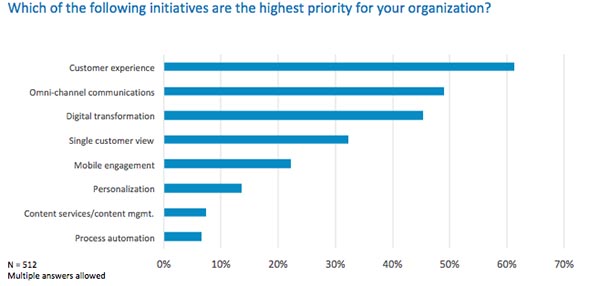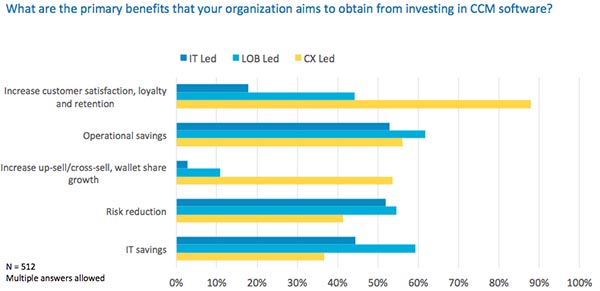As we enter the third decade of the 21st century, the Customer Communications Management (CCM) market is undergoing radical changes on an evolutionary scale. In order to better understand the forces behind this evolution, late last year, Aspire CCS, surveyed businesses across the globe, interviewed stakeholders in every facet of the market, and published an extensive report entitled “The State of CCM-to-CXM Transformation.”
This four-part series, published in partnership with WhatTheyThink, will take a look at some of the key takeaways from this research by first examining the forces driving this evolution. In the later installments, we’ll explain what the findings mean for service providers and technology vendors, and finally chart a course that will help enterprises thrive in the emerging market ecosystem.
There are three main forces behind the CCM market’s evolution, but we can trace the epicenter to a fundamental shift in enterprise priorities. Consumer expectations of instant access to relevant, personalized information has made customer experience an increasingly important metric in B2C communications. As a result, enterprise communication priorities are shifting from reducing cost and risk to increasing business value. Aspire’s survey found that customer experience (CX) was the top priority for nearly two-thirds of the more than 500 businesses surveyed globally, outpacing all other perennial customer communications concerns.
Corporate Priorities

Source: Aspire, The State of CCM-to-CXM Transformation, 2019
Today’s rapidly changing technological landscape is also reshaping the market. Advances in cloud and other emerging technologies, an exploding digital marketing technology ecosystem, and faster adoption through increasing business model innovation and license flexibility are all evolutionary factors. Digitization, AI-assisted processing, and data analysis can help enterprises realize the promise of true bi-directional interaction with customers instead of static, one-way messaging. CCM vendors are adjusting their approach in order to take advantage of these developments so that they can offer their clients the best chance for success in this new market paradigm.
Finally, one of the most fundamental and transformative changes in market technology is the shift from on-premise CCM installation to cloud-based distribution. Aspire’s research indicates that businesses are growing more comfortable with the cloud. Across all the surveyed organizations, job roles, and verticals, CCM purchase preference is shifting toward subscriptions. CCM cloud migration provides a range of benefits, both tactical (reduction in operating costs and security risks) and strategic (instant scalability and faster integration allowing experimentation in workflow). Ultimately, cloud-based distribution will allow enterprises and service providers to integrate CCM with a wider set of digital (marketing) technologies that aim to optimize customer experience by putting consumers front and center.
Instant access to relevant information, personalized experiences on a preferred channel, and consistent communications in terms of style, branding, and tone-of-voice have become crucial elements of superior CX and all three of the primary dynamics behind CCM’s evolution share one thing in common: They are designed to enable business users to improve CX for the end consumer.
For this reason, Aspire believes Customer Communications Management has effectively become part of Customer Experience Management (CXM), or the practice of managing all interactions that a business conducts with its customers with the express goal of improving the perception that customers have about that business. The zenith of this transformation would see an indelible shift from traditional outbound messaging triggered by regulatory requirements, toward customer-centric, two-way interactions based on consumer’s needs and calibrated to their preference and convenience.
Since customer experience is the sum of all interaction during the entire lifecycle, true transformation means not only evolving technology to fully understand customer behavior and the ability to interact in a channel and device-agnostic way, it also may require organizational changes to overcome functional siloes and improve coordination and collaboration, as well as developing more agile and automated processes. CXM strategy makes efficient use of customer data and insights to understand their needs, behavior, and communication preferences, looking holistically across all touchpoints and channels to understand where the experience is broken or can be improved. If executed well, it will drive loyalty, retention, up-sell/cross-sell opportunities, or reduced service cost.
CXM: A New Market Ecosystem

Source: Aspire, The State of CCM-to-CXM Transformation, 2019
This evolution is creating an ecosystem in which any number of business solutions, including Customer Relationship Management (CRM), Enterprise Content Management (ECM), process automation, and more, are extended with a communications or customer experience technology layer, and all the components are connected through an integration platform.
Aspire believes that this ecosystem will be increasingly provisioned through cloud-based, micro-services architectures, continually optimized with the overarching goal of providing personalized, channel, and device-agnostic communications and digital experiences at scale, all in the name of improved customer experience and increased business value. Our research found that businesses embracing a transformative strategy centered around customer interactions (instead of traditional one-way messaging) were much more likely to report that their CCM investments had increased customer satisfaction and up-sell/cross-sell opportunities in addition to delivering operational savings.
Primary Benefits of Investing in CCM

Source: Aspire, The State of CCM-to-CXM Transformation, 2019
As the graphic here illustrates, an organization’s CCM investments are guided by its perception of customer communications and their place along the path from CCM to CXM transformation.
In the most rudimentary environments, IT continues to control CCM. The organization retains a document-centric perspective. Instead of being guided by coordinated strategy, their CCM investments are reactionary and defined in terms of cost and risk reduction. Investments are reactionary rather than proactive, initiated by the renewal of a print agreement, the end of a system life cycle, or the passage of new regulatory requirements. Advancements tend to be more tactical in nature, like a “lift and shift” or migrating from print to digital communications, though, characteristically, this digital push is aimed at cutting postage expense rather than achieving a more valuable (albeit intangible) benefit, like improving CX.
As organizations advance along their evolutionary journey, the needs of the business eventually eclipse cost savings as the primary motivator in CCM investments. Investments in this transitionary stage are directed by the line of business and focused on securing the agility and adaptability necessary to achieve the fastest time to market through the customer’s preferred channel. While cost reduction still remains important to fund those new initiatives, the primary driver is to achieve higher customer satisfaction. However, needs are often expressed from “inside-out” thinking that doesn’t consider actual consumer need, leading to requests for digital and mobile services and channels often without understanding what problem they solve or why they’re needed.
To reach the third and final stage of CXM maturity, organizations must place the needs of the customer ahead of the business when planning B2C communications strategy. True converts to CXM prioritize CX through data analytics and the development of meaningful customer and journey insights. Within these systems, customer communications are owned and managed by a centralized CX team or steering committee who understand the journeys that customer take across all touchpoints and continuously monitor them to ensure that those experiences are optimized and relevant. For services providers, the opportunity here is to provide a modern platform that allow customers to achieve greater business value through consistent and personalized omnichannel communications.
In the next part of our on-going series, we will lay out the five steps to CXM maturity and explain how service providers can upgrade their technology and strategy to move up the scale, ensuring their long-term viability. In the meantime, if you’d like to learn more about Aspire or the full report please reach out to me at [email protected].










Discussion
Join the discussion Sign In or Become a Member, doing so is simple and free